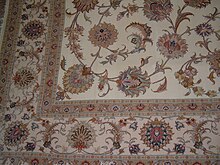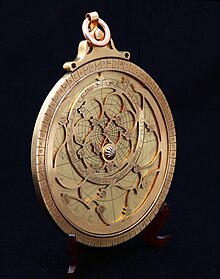Arts of Iran


The arts of Iran are one of the richest art heritages in world history and encompasses many traditional disciplines including architecture, painting, literature, music, weaving, pottery, calligraphy, metalworking and stonemasonry. There is also a very vibrant Iranian modern and contemporary art scene, as well as cinema and photography. For a history of Persian visual art up to the early 20th century, see Persian art, and also Iranian architecture.
The Persian Fine Arts
The Persian rug

The art of rug weaving in has its roots in the culture and customs of its people and their instinctive feelings. Weavers mix elegant patterns with a myriad of colors. The Iranian carpet is similar to the
The colors are usually made from wild flowers, and are rich in colors such as burgundy, navy blue, and accents of ivory. The proto-fabric is often washed in
The exceptional craftsmanship in weaving these carpets and silken textile thus caught the attention of the likes of Xuanzang, Jean-Baptiste Tavernier, and Jean Chardin.
Painting and miniature
Oriental historian Basil Gray[2] believes Iran (Persia) " has o unique [sic] art to the world which is excellent in its kind".
Caves in Iran's
Painting in Iran is thought to have reached a climax during the
Paintings of the
Pottery and ceramics

Prominent
Of the thousands of archeological sites and historic ruins of Iran, almost every single one can be found to have been filled, at some point, with earthenware of exceptional quality. Thousands of unique vessels alone were found in
The occupation of the potter ("kuzeh gar") has a special place in Persian literature.
Music
During the course of Iran's recorded history, a unique distinctive music developed accompanied by numerous musical instruments, several of which came to be the first prototypes of some modern musical instruments of today.
The earliest references to musicians in Iran are found in Susa and Elam in the 3rd millennium BC. Reliefs, sculptures, and mosaics such as those in Bishapur from periods of antiquity depict a vibrant musical culture.
Literature
Persian literature is by far the most stalwart expression of the Iranian genius. While there are interesting works in prose, it is poetry where the Iranian literature shines at its most. Flourishing over a period of more than a millennium, it was esteemed and imitated well beyond the confines of the Iranian homeland. The literature of Iran's direct and recently lost territories in the Caucasus (most notably Azerbaijan), as well as Turkey and indirectly the Mughal Empire developed under its influence.
Some notable
Environmental design
Architecture
The architecture of Iran is one with an exceedingly ancient Persian tradition and heritage. As
Persian gardens
The tradition and style in the garden design of Persian gardens (Persian باغ ایرانی) has influenced the design of gardens from Andalusia to India and beyond. The gardens of the Alhambra show the influence of Persian Paradise garden philosophy and style in a Moorish Palace scale from the era of Al-Andalus in Spain. The Taj Mahal is one of the largest Persian Garden interpretations in the world, from the era of the Mughal Empire in India.
- Examples: see Category: Persian Gardens
Calligraphy
Says writer Will Durant: "Ancient Iranians with an alphabet of 36 letters, used skins and pen to write, Instead of earthen tablets". Such was the creativity spent on the art of writing. The significance of the art of calligraphy in works of pottery, metallic vessels, and historic buildings is such that they are deemed lacking without the adorning decorative calligraphy.
- Shekasteh
- Nasta'liq
- Naskh
- Mohaqqaq
Tilework
The tilework is a unique feature of the blue mosques of . In the old days, Kashan (kash + an which literally means "land of tiles") and Tabriz were the two famous centers of Iranian mosaic and tile industry.
Cinema
With 300 international awards in the past 25 years, films from Iran continue to be celebrated worldwide. Few of the best known directors are Abbas Kiarostami, Mohsen Makhmalbaf, and Majid Majidi.


Metalwork (Ghalam-zani)

Luristan bronzes, probably from around 1000-650 BCE, are a distinctive group of small objects decorated with figures of animals and human in inventive and vigorous poses.
Khatam-kari

Delicate and meticulous marquetry, produced since the
Coming from techniques imported from China and improved by Persian know-how, this craft existed for more than 700 years and is still perennial in Shiraz and Isfahan.
Mina-kari

Enamel working and decorating metals with colorful and baked coats is one of the distinguished courses of art in Isfahan . Mina, is defined as some sort of glasslike colored coat which can be stabilized by heat on different metals particularly copper. Although this course is of abundant use industrially for producing metal and hygienic dishes, it has been paid high attention by painters, goldsmiths and metal engravers since long times ago.
In the world, it is categorized into three kinds as below:
- painting enamel
- Charkhaneh or chess like enamel
- Cavity enamel.
What of more availability in Isfahan is the painting enamel of which a few have remained in the museums of Iran and abroad indicating that Iranian artists have been interested in this art and used it in their metal works since the
Now after a few years of stagnation since 1992, this art has started to continue its briskness having a lot of distinguished artists working in this field. To prepare an enameled dish, the following steps are used. First, choose the suitable dish by the needed size and shape which is usually made by a coppersmith. Then, it is bleached through enameled working which is known as the first coat. It is then put into a seven hundred and fifty degree furnace. At this stage, the enameled metal will be coated with better enamels a few more times and again reheated. The dish is then ready to be painted. The Isfahanian artists, having been inspired by their traditional plans as arabesque, khataii (flowers and birds) and using fireproof paints and special brushes, have made painting of Isfahan monuments such as step, the enameled material is put into the furnace again and heated at five hundred degrees. This causes the enameled painting to be stabilized on the undercoat, creating a special "shining" effect. Most of today's enamel workings are performed on dishes, vases, boxes and frames in various size.
Relief and sculpture
Other handicrafts
- Galesh
- Giveh
- Iranian Termeh
- Persian Jewels
- Kalamkari
| Part of a series on the |
| Culture of Iran |
|---|
 |
|
|
See also
- Azerbaijani art
- Culture of Iran
- Cultural Heritage, Handcrafts and Tourism Organization
- Graffiti in Tehran
- International rankings of Iran
- Iran's House of Art
- Iranian modern and contemporary art
- List of Persian painters
- Persian theatre
- Qajar art
- Safavid art
Gallery
-
Parthian Man Statue, National museum of Iran
-
Kerman Carpet
-
Pateh, Kerman
-
Tiles, Ibrahim Khan Complex, Kerman
References
- ^ "BBCPersian.com". bbc.co.uk.
- ^ "Iranica.com - GRAY, BASIL". Archived from the original on 2005-02-01. Retrieved 2006-01-26.
Further reading
- Carboni, S. & Masuya, T. (1993). Persian tiles. New York: The Metropolitan Museum of Art.
- Swietochowski, Marie Lukens & Babaie, Sussan (1989). Persian drawings in the Metropolitan Museum of Art'. New York: The Metropolitan Museum of Art. ISBN 0870995642.













